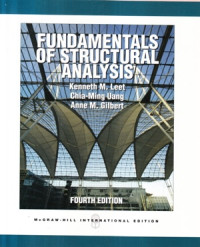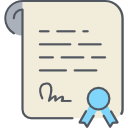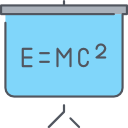Text
Fundamentals of structural analysis
This text introduces engineering and architectural students to the basic tech-'- Jes required for analyzing the majority of structures and the elements of • r.ich most structures are composed, including beams, frames, arches, ."-•>es. and cables. Although the authors assume that readers have com-" r.ed basic courses in statics and strength of materials, we briefly review 3ie basic techniques from these courses the first time we mention them. To :urif\ the discussion, we use many carefully chosen examples to illustrate 7K various analytic techniques introduced, and whenever possible, we •eiect examples confronting engineers in real-life professional practice.
:eatures of This Text
1. Historical Notes. New to this edition are historical notes that have
been added to various chapters providing points in the history of
accomplishments and developments in structural analysis methods.
2. Expanded treatment of design loads. Chapter 2 is devoted to a
comprehensive discussion of loads that include dead and live loads,
snow, earthquake, and wind loads Based on the ANSI/ASCE 7 Stan¬
dard. The presentation aims to provide students with a basic under¬
standing of how design loads are determined for practical design of
multistory buildings, bridges, and other structures.
3. New homework problems. A substantial number of the problems
are new or revised for this edition (in both metric and U.S. Cus¬
tomary System units), and many are typical of analysis problems
encountered in practice. The many choices enable the instructor to
select problems suited for a particular class or for a particular
emphasis.
Computer problems and applications. Computer problems,
some new to this edition, provide readers with a deeper under¬
standing of the structural behavior of trusses, frames, arches, and
other structural systems. These carefully tailored problems illus¬
trate significant aspects of structural behavior that, ni the past,
experienced designers needed many years of practice to under¬
stand and to analyze correctly. The computer problems are identi¬
fied with a computer screen icon and begin in Chapter 4 of the
text.
Ketersediaan
Informasi Detail
- Judul Seri
-
-
- No. Panggil
-
690.1 Lee f
- Penerbit
- New York : Mc Graw-Hill., 2011
- Deskripsi Fisik
-
xxii, 788 hal. : il. ; 25 cm.
- Bahasa
-
English
- ISBN/ISSN
-
9780071289382
- Klasifikasi
-
690.1
- Tipe Isi
-
-
- Tipe Media
-
-
- Tipe Pembawa
-
-
- Edisi
-
Ed. IV
- Subjek
- Info Detail Spesifik
-
-
- Pernyataan Tanggungjawab
-
-
Versi lain/terkait
Tidak tersedia versi lain
Lampiran Berkas
Komentar
Anda harus masuk sebelum memberikan komentar

 Karya Umum
Karya Umum  Filsafat
Filsafat  Agama
Agama  Ilmu-ilmu Sosial
Ilmu-ilmu Sosial  Bahasa
Bahasa  Ilmu-ilmu Murni
Ilmu-ilmu Murni  Ilmu-ilmu Terapan
Ilmu-ilmu Terapan  Kesenian, Hiburan, dan Olahraga
Kesenian, Hiburan, dan Olahraga  Kesusastraan
Kesusastraan  Geografi dan Sejarah
Geografi dan Sejarah